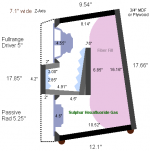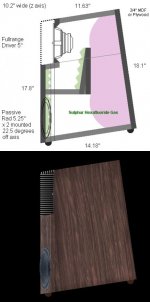This is a hybrid design I created with small (desktop) size in mind. Its a partially stuffed folded pipe with driver 1/3rd from tapered end. I added a passive radiator in place of a vent to hold in the sulphur hexafluoride gas. Sound in this gas is slowed down to 44% of its speed in normal air. It is 6 times denser than air.
Fountek FR135EX 5" Full Range
https://www.madisound.com/store/product_info.php?cPath=45_241_307&products_id=8817
Peerless 5.25" Mini Passive Radiator
https://www.madisound.com/store/product_info.php?products_id=1748

Now to build and test.
Quoting Bentoronto from this http://www.diyaudio.com/forums/subwoofers/176324-instantly-deepen-your-sub.html
"The heavy gas, SH6, works in a few different ways.
Tucked behind the driver, it adds to the room in the box.
Tucked into the horn, it makes for a big horn. Similar but nutty variations of front-face gas loading are possible as in the patent pictures.
The third way is by magnifying the cone surface area. Instead of shaking a heavy chuck of cardboard to move air directly, you are using that cone (with force transfered by the heavy gas) to shake a far larger membrane surface.
These gas-filled boxes breathe a bit. About once a year or two, I have to set my speakers so that the gas falls to the bottom and the valve (a Schrader tire valve!) is at the top. After settling a few hours, I add or relieve some air.
I'm no authority to trust, but I think SH6 is pretty inert and innocuous. It can still leak out, like any gas. The danger is that it is an invisible gas that collects in low spots and might get in the way of normal human breathing - and be dangerous.
Given the dramatic lowering of bass resonance(s), sure seems like a good idea for DIYers to try. No leading-edge technology needed. But what do I know?"
Fountek FR135EX 5" Full Range
https://www.madisound.com/store/product_info.php?cPath=45_241_307&products_id=8817
Peerless 5.25" Mini Passive Radiator
https://www.madisound.com/store/product_info.php?products_id=1748

Now to build and test.
Quoting Bentoronto from this http://www.diyaudio.com/forums/subwoofers/176324-instantly-deepen-your-sub.html
"The heavy gas, SH6, works in a few different ways.
Tucked behind the driver, it adds to the room in the box.
Tucked into the horn, it makes for a big horn. Similar but nutty variations of front-face gas loading are possible as in the patent pictures.
The third way is by magnifying the cone surface area. Instead of shaking a heavy chuck of cardboard to move air directly, you are using that cone (with force transfered by the heavy gas) to shake a far larger membrane surface.
These gas-filled boxes breathe a bit. About once a year or two, I have to set my speakers so that the gas falls to the bottom and the valve (a Schrader tire valve!) is at the top. After settling a few hours, I add or relieve some air.
I'm no authority to trust, but I think SH6 is pretty inert and innocuous. It can still leak out, like any gas. The danger is that it is an invisible gas that collects in low spots and might get in the way of normal human breathing - and be dangerous.
Given the dramatic lowering of bass resonance(s), sure seems like a good idea for DIYers to try. No leading-edge technology needed. But what do I know?"
Last edited:
To avoid all kinds of troubles related to gas leak, how about freezing the air inside?
By dropping the temperature, air gets denser. Talk about fridge-like speaker! LOL
By dropping the temperature, air gets denser. Talk about fridge-like speaker! LOL
.........
Tucked into the horn, it makes for a big horn. Similar but nutty variations of front-face gas loading are possible as in the patent pictures.
The third way is by magnifying the cone surface area. Instead of shaking a heavy chuck of cardboard to move air directly, you are using that cone (with force transfered by the heavy gas) to shake a far larger membrane surface.
........
In that case, wouldn't it be better to have more than one of these passive radiators, or maybe even go to an 8" one?
Shouldn't be much leakage with the interior coated and sealing putty under the driver rims.
More concerned with the internal volume, but a pair of side radiators would be interesting.
"Tucked behind the driver, it adds to the room in the box."
More concerned with the internal volume, but a pair of side radiators would be interesting.
"Tucked behind the driver, it adds to the room in the box."
Shouldn't be much leakage with the interior coated and sealing putty under the driver rims.
When Dayton-Wright did this the gas was in a plastic bag.
dave
Hi, I'd walk before you can run and take on board very dubious claims, rgds, sreten.
undefinition
Zaph|Audio
FRD Consortium tools guide
RJB Audio Projects
Speaker Design Works
HTGuide Forum - A Guide to HTguide.com Completed Speaker Designs.
Humble Homemade Hifi
Click below to go to
Quarter Wavelength Loudspeaker Design
The Frugal-Horns Site -- High Performance, Low Cost DIY Horn Designs
Linkwitz Lab - Loudspeaker Design
Music and Design
undefinition
Zaph|Audio
FRD Consortium tools guide
RJB Audio Projects
Speaker Design Works
HTGuide Forum - A Guide to HTguide.com Completed Speaker Designs.
Humble Homemade Hifi
Click below to go to
Quarter Wavelength Loudspeaker Design
The Frugal-Horns Site -- High Performance, Low Cost DIY Horn Designs
Linkwitz Lab - Loudspeaker Design
Music and Design
- Status
- Not open for further replies.
- Home
- Loudspeakers
- Full Range
- Voigt Pipe Fullrange with Radiator
